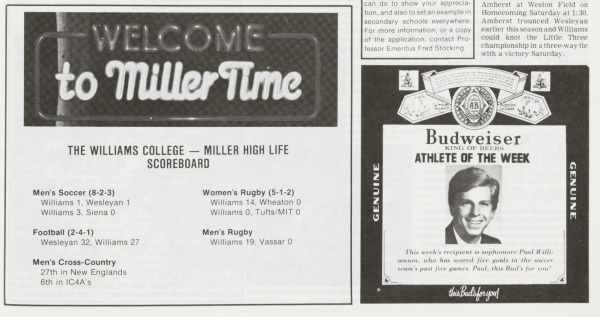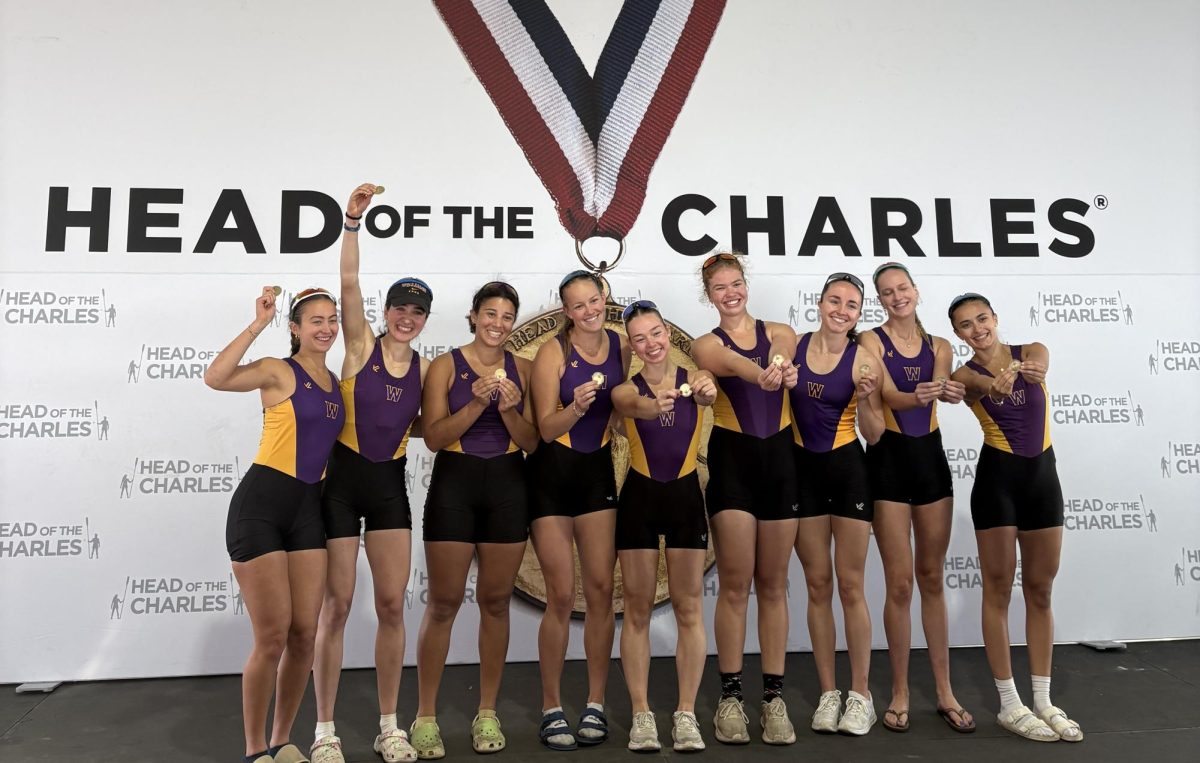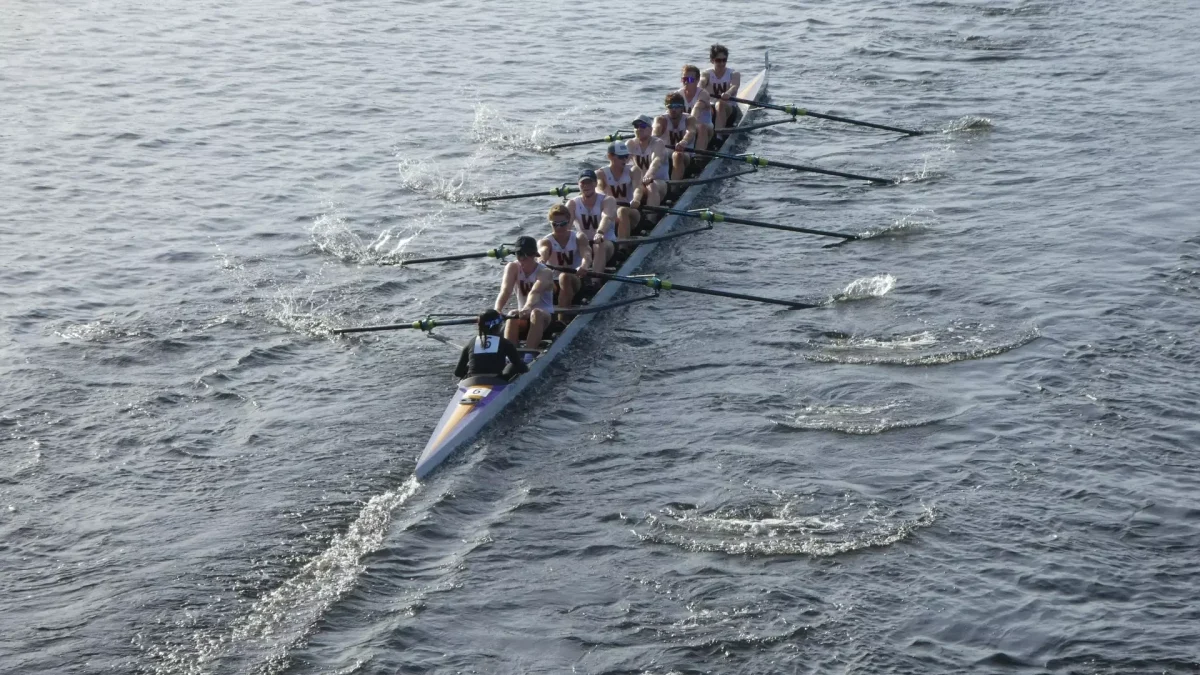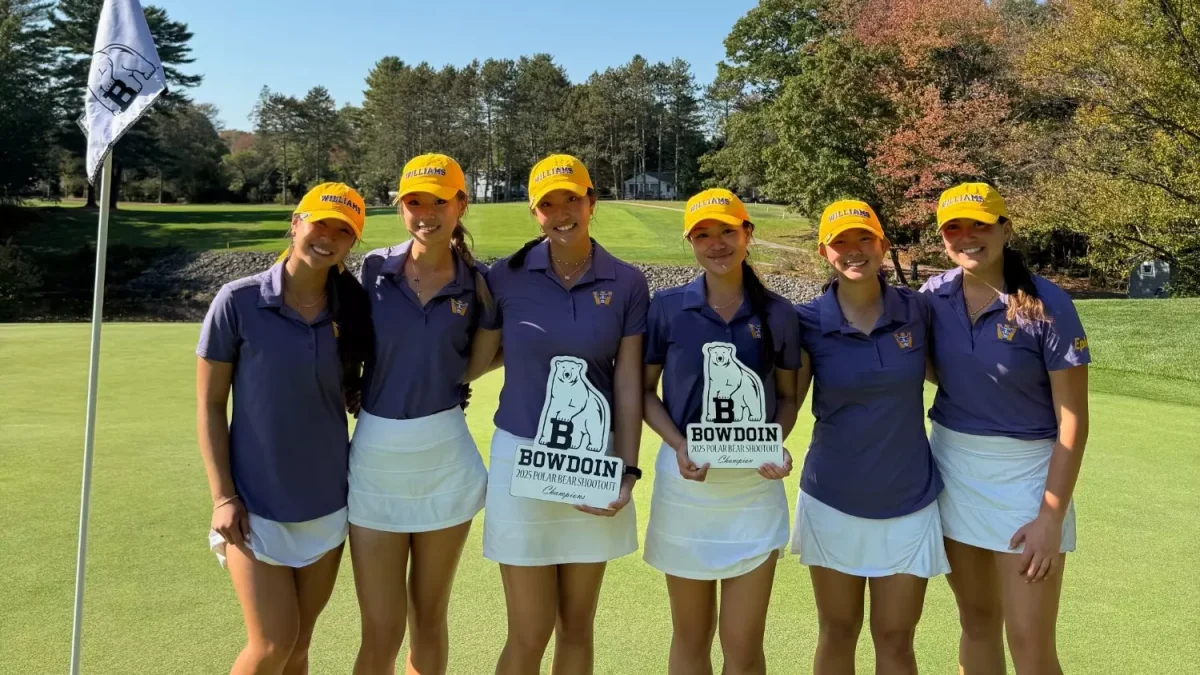
The year is 1982 and the old Lasell pool stands are packed. It seems like the entirety of campus has decided to show up for the club water polo game against Amherst. Why? Certainly not to watch high-level water polo. According to Will Andrew ’86, one of the day’s starters, almost none of the team members had ever played the sport before joining the club.
The reason was simple: alcohol. “[The team] put a keg up in the stands of the little old pool that they had at the time and everybody told everybody,” Andrew said. “So there were probably 50 people, but it looked like the place was rocking.”
According to Andrew, the team went on to win with 17 goals, nine of which he scored.
A four-inch by four-inch box in the following week’s Record commemorates both Andrew’s performance and the widespread hangovers the next morning. The box featured a picture of Andrew surrounded by the Budweiser crest and the message “Will, this Bud’s for you.”
The “Budweiser ‘King of Beers’ Athlete of the Week” was an institution at the Record during the 1980s, highlighting the exceptional play of one student athlete each week. For every issue, a new athlete would be selected by the sports editors and a short blurb would highlight their success.
“It was actually a fairly easy process,” recalled John Clayton ’85, a former sports editor and later the editor-in-chief of the Record. “If someone scores three touchdowns or 30 points in a basketball game or a couple of hat tricks, that person is sort of the MVP.”
While the overt marketing of alcohol to 18 to 22-year-olds may seem unusual today, it was a product of its time, Clayton explained. “Alcohol was a much bigger factor in campus life than I think it is now,” he said.
In Clayton’s opinion, the social importance of alcohol was driven by a number of factors. “Marijuana was illegal, so in terms of party aides, alcohol was really it,” he said. Also, because the drinking age at the time was 20, juniors and seniors were of age. “Because it was a sort of half-and-half thing, there was a lot more tolerance of, for example, advertising alcohol in the paper,” Clayton said.
Alcohol companies knew about beer’s hold on the College. “With beer being such a big factor in student life, the beer companies wanted to harness that,” Clayton said.
Two companies made a hoppy splash on the pages of the Record: Miller and Budweiser. “I mean, it was sort of a duopoly with these two huge companies,” Clayton said.
The two firms competed fiercely. Budweiser and Miller fought tooth and nail to promote their product to the student body. To accomplish this goal, they waged a war of soft power from the inside out.
“They hired these campus reps … who tended to be big partiers on campus who would always be drinking Budweiser, and so it was sort of cool to be drinking Budweiser,” Clayton said.
If Budweiser had campus representatives, you can bet that Miller had them too. John Schafer ’87, Clayton’s colleague at the Record, had a Junior Advisor who was one of these representatives. “My JA [Paul Meeks ’85], was the Miller rep on campus,” Schafer said. “He had an illuminated Miller [sign] they put on this window that you’d see [from] a long way away.”
These representatives were staples of the community. “[Meeks was a] big time athlete: Charming, he played football and lacrosse,” Schafer said. “He was funny and he was charismatic and that’s why Miller tapped him to be [their] rep.”
Despite having Meeks in its corner, Miller was up against tough competition. As Clayton recalled, Budweiser was generally considered to be the cooler beer.
A key way that the Budweiser reps sustained this reputation was the “Budweiser Athlete of the Week” title. Schafer recalls that the Budweiser reps pitched the concept to the Record and were responsible for making it work. “They passed a little bit of money [to the Record] to run it,” he explained.
“In Budweiser’s mind, the ‘Athlete of the Week’ ad was part of that victory [over Miller], because it was an incredibly popular feature in the paper,” Clayton said.
This designation meant something to the athletes, too. “You’d be sitting with the other folks on the team and say, ‘Well I’m the ‘Athlete of the Week’ … I get to sit at the head of the table,’” Andrew remembered.
Andrew is not the only athlete who recalled the pride associated with winning the title. “The [‘Athlete of the Week’] distinction came the same time that I was featured in the April 1988 edition of Sports Illustrated for being the first Black All-American in squash,” Wendell Chestnut ’88 said. “It was sort of like that 15 minutes of fame scenario.”
Faced with such a strong form of advertisement, Miller tried to strike back on the same page of the paper. “Miller was really jealous of [Budweiser’s dominance],” Clayton said. “And, during my time, Miller actually started a competing ad campaign … the Miller High Life scoreboard.”
The scoreboard was similar to the scores the Record currently features at the top of the sports page, except it almost exclusively highlighted wins for the College. This warm and fuzzy feeling that Miller was trying to evoke was meant to distract from Budweiser’s sponsorship of the “Athlete of the Week” column.
Despite the aggressive move, the Miller reps’ efforts were not enough to oust the “King of Beers” from its on-campus throne. “Because it was a scoreboard, [and because] it wasn’t focused on individuals, it didn’t seem to me that it was really drawing the same appeal that the ‘Athlete of the Week’ did,” Clayton said.
As the 1980s came to a close and the real Cold War fizzled out, the College’s cold beer war also went the way of the dinosaur. “In the late 1980s, when the drinking age went up to 21, those policies [of tolerance towards drinking] really changed,” Clayton said.
While alcohol is by no means gone from the College, its institutionalization in columns such as the Miller Scoreboard and the “Budweiser Athlete of the Week,” has been lost to time. By the 1990s, the title had been officially changed to simply “Athlete of the Week.”
As the influence of Miller and Budweiser has faded, the true meaning of the “Athlete of the Week” still shines through. “You knew Budweiser was a beer and Miller was a beer, but it was more the fact that it was the athlete of the week … You were more focused on the person and the sport,” Chestnut said.








